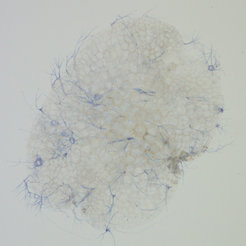An evolutionary approach to understand the plant immune system
Supervision: The project will be supervised by Hirofumi Nakagami at the Max Planck Institute for Plant Breeding Research.
Abstract: During the last several decades, extensive analyses revealed that plants utilize a two-branched immune system for defense against pathogens. In the first branch, transmembrane pattern recognition receptors (PRR), which are membrane-associated kinase or membrane-associated kinase interacting protein recognize and respond to slowly evolving pathogen-associated molecular patterns (PAMP). In the second branch, either a direct or an indirect recognition of the pathogen through disease-resistance (R) proteins is used for response to pathogen virulence factors (effectors). However, most insights gleaned to date have been mostly limited to seed plants. Consequently, we still know little about the conservation and diversification of the immune system among highly diverged plant species. Thus, we have been establishing tools to study immunity-related components in the model liverwort Marchantia polymorpha (1,2). The majority of immune-related genes characterized in seed plants have been identified in M. polymorpha genome (3). Importantly, M. polymorpha probably did not undergo whole-genome duplication, with the consequence that genetic redundancy is low. The overall simplicity of gene families in M. polymorpha holds advantages for molecular genetic analysis. Analysis of M. polymorpha with simple gene/protein networks has great potential to understand ancestral and fundamental mechanisms in plant immune system. Our main goal is to illustrate a fundamental immune system in plants. In this project, we aim to characterize components that presumably play roles in immune system in M. polymorpha by taking genetic, transcriptomic and proteomic approaches (1,4-6).
Link to the Nakagami group homepage: https://www.mpipz.mpg.de/nakagami

References:
(1) Carella P, Gogleva A, Hoey DJ, Bridgen AJ, Stolze SC, Nakagami H, Schornack S. (2019). Conserved biochemical defenses underpin host responses to oomycete infection in an early-divergent land plant lineage. Curr Biology. 29(14):2282-2294.e5.
(2) Matsui H, Iwakawa H, Hyon GS, Yotsui I, Katou S, Monte I, Nishihama R, Franzen R, Solano R, Nakagami H. (2020). Isolation of natural fungal pathogens from Marchantia polymorpha reveals antagonism between salicylic acid and jasmonate during liverwort-fungus interactions. Plant and Cell Physiology. 61(2):442.
(3) Bowman JL, Kohchi T, Yamato KT, …, Nakagami H, … et al. (2017). Insights into Land Plant Evolution Garnered from the Marchantia polymorpha Genome. Cell. 171(2):287-304.e15.
(4) Koide E, Suetsugu N, Iwano M, Gotoh E, Nomura Y, Stolze SC, Nakagami H, Kohchi T, Nishihama R. (2020). Regulation of photosynthetic carbohydrate metabolism by a Raf-like kinase in the liverwort Marchantia polymorpha. Plant and Cell Physiology. 61(3):631-643.
(5) Matsui H, Nomura Y, Egusa M, Hamada T, Hyon GS, Kaminaka H, Watanabe Y, Ueda T, Trujillo M, Shirasu K, Nakagami H. (2017). The GYF domain protein PSIG1 dampens the induction of cell death during plant-pathogen interactions. PLoS Genetics. 13(10):e1007037.
(6) Nobori T, Wang Y, Wu J, Stolze SC, Tsuda Y, Finkemeier I, Nakagami H, Tsuda K. (2020). Multidimensional gene regulatory landscape of a bacterial pathogen in plants. Nature Plants. 6(7):883-896.
